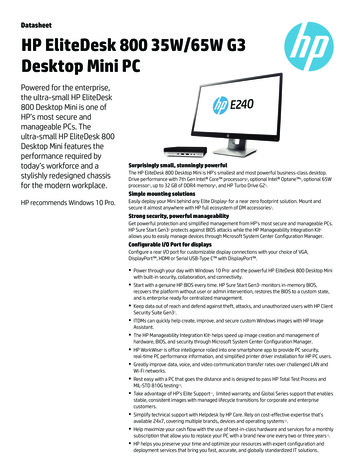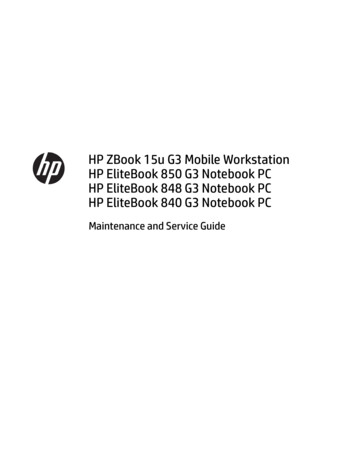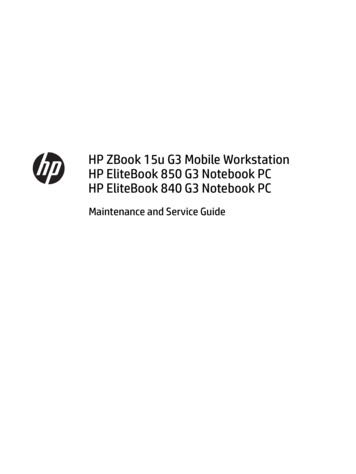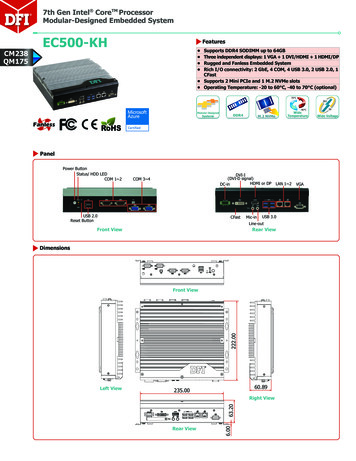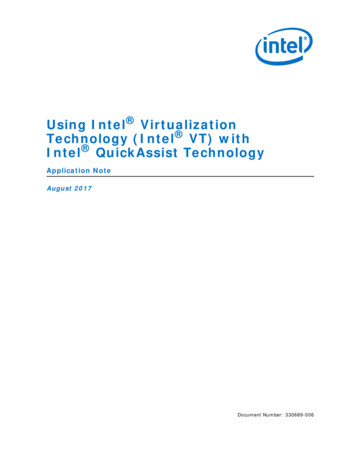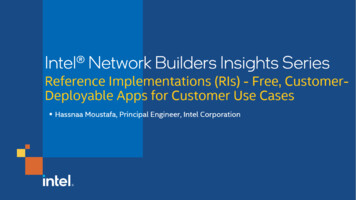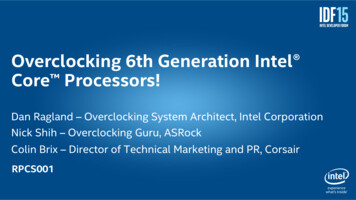
Transcription
Overclocking 6th Generation Intel Core Processors!Dan Ragland – Overclocking System Architect, Intel CorporationNick Shih – Overclocking Guru, ASRockColin Brix – Director of Technical Marketing and PR, CorsairRPCS0011
WARNING:Alteringclockfrequencyand/or voltagemay: (i) reduce system stability and useful life of the systemand processor; (ii) cause the processor and other system componentsto fail; (iii) cause reductions in system performance; (iv) causeadditional heat or other damage; and (v) affect system data integrity.Intel has not tested, and does not warranty, the operation of theprocessor beyond its specifications. Intel assumes no responsibilitythat the processor, including if used with altered clock frequenciesand/or voltages, will be fit for any particular purpose.For more information, wer.htm2
Agenda Overclocking (OC) Architecture: Intel Core i7-6700K processor withIntel Z170 Chipset Live Overclocking Demonstration! Motherboard Technology for OC OC Architecture: 8-Core OC on Intel X99 Chipset Tools and Technology for OC OC Extended Ecosystem Summary and Q&A3
Agenda Overclocking (OC) Architecture: Intel Core i7-6700K processor withIntel Z170 Chipset Live Overclocking Demonstration! Motherboard Technology for OC OC Architecture: 8-Core OC on Intel X99 Chipset Tools and Technology for OC OC Extended Ecosystem Summary and Q&A4
Overclocking SKU Options:for 6th Generation Intel Core ProcessorsOverclocking CapabilitiesIntel Core i7-6700KIntel Core i5-6600KIntel 100 Series ChipsetIntel Z170 Chipset5 Unlocked BCLK FrequencyUnlocked Processor RatiosUnlocked Memory RatioUnlocked Processor Graphics RatioUnlocked Voltage controls
Overclocking Feature ComparisonIntel Core i7-3770KprocessorIntel Core i7-4790KprocessorIntel Core i7-6700KprocessorUp to 63Up to 80Up to 83 LimitedCoarse Ratio 100, 125, 167MHz100 to 200MHz in 1MHzincrementsSVID Extra Voltage (Cores, GT)FIVR: SVID Extra Voltage,Voltage Override, InterpolativeSVID Extra Voltage, VoltageOverride, InterpolativeΔ Processor Graphics OverclockingAll chipsetsAll chipsetsZ170 onlyΔ Available DDR Ratio/FrequencyUp to 2667Up to 2667Up to 4133200/266 MHz200/266 MHz100/133 MHz1.31.32.0Δ Available Core Ratio OverridesReal-time Core Ratio, PL, IccMax ControlΔ BCLK OverclockingΔ MSR Voltage ControlOverrides and MRCΔ DDR Granularity StepsΔ XMP Memory Reference CodeΔ New or significant change for this generation.6Features are subject to change. Features shown are available in select SKUs. Overclocking results not guaranteed.
Overclocking Architecture Overview C G MCore Frequency- Unlocked core ratios up to 83 in 100MHz increments†- Complete Turbo overrides for Voltage, Power Limits,IccMaxGraphics Frequency (pGfx)- Unlocked graphics ratios up to 60 in 50MHz increments†- Turbo Voltage controlsMemory Ratio- Options for 100 and 133 MHz steps†- Logical ratios up to at least 4133 MHz†BCLK-7PCIe PCI Express pGfx Intel Processor GraphicsPCH clock controller1MHz incrementsUp to 200 MHz or higher†Note: Discrete clocking solutions exist which enable finerthan 1MHz increments and ranges far 250MHz ††7Subject to change at any time. Overclocking results not guaranteed.
Clocking Options (BCLK) No more PEG/DMI ratios required! (125/16) BCLK has full fine grain overclocking capability Option for Discrete BCLK or Integrated (PCH) PEG/DMI domain has isolated 100 MHz clockMotherboard ODMs may offer discrete BCLK control forextreme overclocking results!8PCI Express (PCIe)
Clock Tree: BCLK TuningBCLKin 1 MHz stepsCoresLast Level Cache PCI Express (PCIe) BCLK(100MHz SSC) has adedicated reference clockSystemAgentGTPEGDMI9Ring BCLK input comes from PCHDDRPCIe & DMI
VDDQVoltage PlanesVRINGDDRup to 1.52V (SVID) plus“Vboost” offsetVCORE VGT : dynamic VR up toCoresLast Level CacheVGTpGfxPCI Express DMIVSA10SystemAgent1.52V (SVID) plus offset VDDQ: 1.2V Nom for DDR4Ring VCORE & VRING: dynamic VR
Processor Core Voltage Control Modes11voltsXEXEturbonon-turboOverride V/fXEturbonon-turbofreq11freqOffset V/fvoltsOffset ( /-) isapplied to theentire curve andcan be combinedwith Override orInterpolationturbonon-turboXEturbofreq Interpolation (adaptive)in the overclockingregion: Target Based Override applied to theentire curve. Used forextreme OC Tradeoff:higher power andlower tion V/fvolts non-turboFused V/ffreq11
Intel Microarchitecture Codename Skylake was Designedfor Overclocking!1. Core Overclocking performance improvements Overclock-ability of CPU cores is great! Instructions per clock (IPC) improvements2. Significant BCLK base-clock Overclocking enhancements BCKL granularity now 1MHz increments (was coarse ratios 125/167 on prior gen) Up to 2X BCLK frequency gain, over i7-4790K, with reports at 400MHz in LN2†3. Amazing DDR4 Overclocking Ratios up to 4133MHz† and improved granularity (100/133) Intel Memory Reference Code support for overclocking12†Overclocking capabilities are subject to change at any time. Overclocking results not guaranteed.
Extreme Overclocking AchievementsAchieved on launch day†Frequency Standingsusing Liquid Nitrogen†7 & 10†Source:13HWBOT article dated 2015-08-07http://hwbot.org/newsflash/2983 skylake the day after 7 world records and 10 global first places 4-Core @ 6.8 GHz DDR4 @ 4,795MT/s BCLK @ 552 MHzDisclaimer: These overclockingresults are not typical. Scores wereachieved by extreme overclockersusing LN2 and other advancedtechniques not commonly available toaverage consumers. Overclockingresults are not guaranteed norcovered by warranty. Extreme risktaking!Rankings change regularly. Visit HWBOT’swebsite for the latest http://hwbot.org
Agenda Overclocking (OC) Architecture: Intel Core i7-6700K processor withIntel Z170 Chipset Live Overclocking Demonstration! Motherboard Technology for OC OC Architecture: 8-Core OC on Intel X99 Chipset Tools and Technology for OC OC Extended Ecosystem Summary and Q&A14
Live Overclocking Demo!15
Agenda Overclocking (OC) Architecture: Intel Core i7-6700K processor withIntel Z170 Chipset Live Overclocking Demonstration! Motherboard Technology for OC OC Architecture: 8-Core OC on Intel X99 Chipset Tools and Technology for OC OC Extended Ecosystem Summary and Q&A16
ASRock* Intel Z170 Chipset OC FormulaCPUSupports 6th Generation Intel Core ProcessorsMemoryExpansionSlotAudioDDR4 – 4 slots4 x PCI Express (PCIe) 3.0 x16, 1 x PCIe 3.0 x1, 1 xPCIe 2.0 x1,1 x Vertical Half-size mini-PCIe7.1 CH (Realtek* ALC 1150), Purity Sound* 3LAN17Intel GbE LANStorage3 x Ultra M.2, 10 x SATA3,3 x SATA* ExpressUSB 3.11 x Type-A1 x Type-CSlide provided by ASRock.
Power Phase and PCB Design18 Power Phase DesignThis flagship motherboard boasts a whopping18 Power Phase Design. Offering unmatchedoverclocking capabilities and enhancedperformance with the lowest temperature.8 Layer, 4 x 2 OZ PCBThe 8 Layer PCB comes with 4 sets of 2 ouncecopper inner layers, delivering lowertemperature and higher energy efficiency foroverclocking.18Slide provided by ASRock.
OC Formula KitManually raise or lower the system'sCPU ratio, BCLK frequency or CPU Vcorevoltage.Reduce 23% power loss anddecrease the connector’stemperature up to 22 .19Toggle Slow Mode for forcing yourCPU to run at its lowest frequency.Enable or disable the PCI Express slots.Activate LN2 Mode to disable theCPU’s thermal protection.Slide provided by ASRock.Learn a few tricks from thechampion.
Intel Extreme Memory Profile SwitchIntel XMP SwitchA convenient onboard switch for loading Intel Extreme Memory Profile (Intel XMP) profiles withouthaving to enter the BIOS.DDR42400, 2666, 2800, 2933,3000, 3200, 3300, 3333 orHigher!20Slide provided by ASRock.
Agenda Overclocking (OC) Architecture: Intel Core i7-6700K processor withIntel Z170 Chipset Live Overclocking Demonstration! Motherboard Technology for OC OC Architecture: 8-Core OC on Intel X99 Chipset Tools and Technology for OC OC Extended Ecosystem Summary and Q&A21
Intel Core i7-5960X Processor Extreme EditionOverclocking Intel’s First 8-Core Desktop Processor 8 Cores, 16 Threads4 channel DDR4-2133 memory support3.0 GHz base frequencyUp to 3.5 GHz Turbo frequencyFully unlocked for performance tuning20 MB Intel Smart CacheIntel Turbo Boost Technology 2.0Intel Hyper-Threading TechnologySupports LGA 2011-v3 socket40 PCI Express 3.0 lanes .highest desktop core count and great overclocking22
Intel Core i7 Processors for High-end Desktop:Based on Socket LGA 2011-3 with Intel X99 Express Chipset C Core FrequencyCPU123- Unlocked Intel Turbo Boost Technology Limits- Unlocked core ratios up to 80 in 100MHzincrements- Programmable voltage offset and overridevoltage via iVRMemory MMemory4 C5678PEGDMI P M Memory Ratio- Unlocked memory controller Unlocked memorycontroller voltage levels- Granularity options for 200 and 266MHz DDMICLK/BCLKDMIOCBCLKNon-OC100MHz23PCI Express (PCIe) DMICLK (aka BCLK)- Unlocked PCH clock controller ( 1MHzincrements upwards of 200MHz) D PPCIE D PEG and DMI Ratios- Variable BCKL: PEG/DMI ratios 5:5, 4:5, 3:5, forBCKL@ 100, 125, and 167 MHz
Voltage PlanesDDRCoresVCCINiVRLast Level CacheIOA,IOD, SAPCI Express (PCIe*)VDDQSystem VCCIN: SVID 1.8V Nom up toAgent VCORE: dynamic additional V,PCIeRing24RingCoreDMI2.3V , static V up to 3.0Vstatic V up to 2.0 V VRING: dynamic additional V,static V up to 2.0 V VDDQ: 1.2V Nom for DDR4
Clock Tree: BCLK Tuning Single BCLK input comes fromPCH in 1MHz stepsAcceptable input to CPU limitedby PCI Express (PCIe) and DMIPLL interface:100MHz x 5-7% PEG/DMI @ 5:5125MHz x 5-7% PEG/DMI @ 5:4167MHz x 5-7% PEG/DMI @ 5:3 Frequency Relationshipsf(Core) BCLK*Core RatioF(Ring) BCLK*Ring Ratiof(DDR) BCLK*1.33*DDR Ratio-orf(DDR) BCLK*1.00*DDR Ratio25
Desktop Processors for Intel X99 Chipset Based SystemsIntel Core i7-5960XIntel Core i7-5930KIntel Core i7-5820K866Clock Speed / Max Turbo Frequency3.0 GHz / 3.5 GHz3.5 GHz / 3.7 GHz3.3 GHz / 3.6 GHzCache / PCI Express Lanes20 MB / 40 lanes15 MB / 40 lanes15 MB / 28 lanesUp to 80Up to 80Up to 80 YesYesYes 2667 2667 2667 1.0, 1.25, 1.671.0, 1.25, 1.671.0, 1.25, 1.67SKUCoresTurbo Ratio OverridesPL1, PL2, Tau, ICCMax OverridesReal-time Core Overclocking (in OS)DDR Frequency Ratio Overrides†DDR Timing OverridesCoarse BCLK Ratios26†Memoryratio capabilities above 2667 via ratio not tested; use BCLK for highest frequencies.
Agenda Overclocking (OC) Architecture: Intel Core i7-6700K processor withIntel Z170 Chipset Live Overclocking Demonstration! Motherboard Technology for OC OC Architecture: 8-Core OC on Intel X99 Chipset Tools and Technology for OC OC Extended Ecosystem Summary and Q&A27
Intel Extreme Memory Profile (Intel XMP) for DDR4 DDR4 is now the focus of Intel’s XMP and memory overclocking efforts First desktop DDR4 platform launched in Q3’2014 with X99 based platforms DDR4 Overclocking modules are available today! The lower the voltage, at a given frequency, the better the quality28Partial list of Intel Extreme Memory Profile (Intel XMP) certified memory vendors.
Intel Extreme Memory Profile (Intel XMP)An Intel XMP enabled BIOSreads the DIMM’s SPD chip atpower-on: determines if XMP issupported Intel XMP Ready: Module has beenprogrammed with an uncertified profileGOOD †1. Systemboots withhighestsupportedJEDECdefinedparameters Intel XMP Certified: Module has passedsupplier test and submission processfor specific CPU and motherboardBEST †2. XMP profile canbe selected bythe end userthrough BIOSsetup3. Reboot toapply29Intel Extreme Memory Profile (Intel XMP)† Goodand Best refer to the level of testing involved in XMP modules.
Intel Extreme Tuning Utility (Intel XTU) Overclocking Software Real-time tuning Monitoring of systemperformance 30Version 6.0 now available for download: http://www.intel.com/go/xtuProfile ManagementApp-Profile PairingBenchmarkingStress TestingHWBOT benchmarkresult submittals
Agenda Overclocking (OC) Architecture: Intel Core i7-6700K processor withIntel Z170 Chipset Live Overclocking Demonstration! Motherboard Technology for OC OC Architecture: 8-Core OC on Intel X99 Chipset Tools and Technology for OC OC Extended Ecosystem Summary and Q&A31
20 Years of Enabling Enthusiasts PC memory Power supplies (PSUs) Cases Liquid CPU coolers Cooling fans Keyboards, mice, headsets32Slide provided by Corsair.
Overclocking Power SuppliesVirtually all of our powersupplies support the lowpower modes provided bythe new generation ofprocessors. These lowpower modes have been inplace since the release of4th generation Intel Core, soif your power supply workswith your 4th or 5thgeneration based system, itwill work with the newmotherboards, too.33Slide provided by Corsair.
Cooling Solutions for Overclocking The mounting mechanism for6th generation processorshasn’t changed from previousversion. All of our Intel-compatibleHydro Series liquid CPUcoolers will work with yournew motherboard, with noadapter necessary.34Slide provided by Corsair.
AIO Water Cooling 101Radiator – the external heatexchanger. In general, thelarger the radiator (both inarea and thickness) , the easierit is to dissipate heatIntegrated pump. Cooled fluidfrom the radiator is pumped inand after the liquid takes on heatfrom the CPU, it gets pumped outto the radiator to expel the heatCold plate – this is the direct heatexchange contact point with theprocessor much like a traditionalheatsink. Material, finish (smoothness),and QC (flatness) contribute to efficiency35Slide provided by Corsair.
Why Liquid Cool?VS Corsair* Hydro* liquid CPU coolers arequieter because fans don’t have to run asfast Hydro coolers are completely selfcontained, with no filling or maintenanceneeded Hydro liquid coolers are more effective thanstock CPU heat sink fans Water cooling efficiency over air cooling issimple physics. Do not argue with physics.36Slide provided by Corsair.
Liquid Cooling vs. Air CoolingThermal Resistance (C/W)Lower Is Better0.170.150.130.110.090.0737 Lower thermal resistanceallows better heatdissipationSlide and data provided by Corsair.
Superior Efficiency of Liquid CoolingCooling 8 Corsair Hydro seriesliquid cooling offersmore efficient andquieter performancethan air coolingSlide and data provided by Corsair.
More Headroom, Faster Performance39Slide provided by Corsair.
Amazing DDR4 Performance!40DDR4 – 4,000 MT/s Dual Channel ( two sticks) with CorsairDDR4 Vengeance LPX memory and ASRock* OC FormulaSlide and data provided by Corsair.
Agenda Overclocking (OC) Architecture: Intel Core i7-6700K processor withIntel Z170 Chipset Live Overclocking Demonstration! Motherboard Technology for OC OC Architecture: 8-Core OC on Intel X99 Chipset Tools and Technology for OC OC Extended Ecosystem Summary and Q&A41
Summary and Next Steps The best keeps getting better, with 6th Generation Intel Core processors!- BCLK is back and better than ever!- Amazing DDR4 Overclocking!- The CPU core performance we’ve all come to expect! Overclocking system innovation opportunities are abundant- Design differentiation opportunities- Form factor and price point scalability The Overclocking Ecosystem is growing and ready for the 6th Generation IntelCore i7-6700K processor- Intel’s Overclocking Software and Technologies provide the baseline- Ecosystem partners provide options from memory to cooling to chassis 42
Additional Sources of Information A PDF of this presentation is available from our Technical Session Catalog:www.intel.com/idfsessionsSF. This URL is also printed on the top of SessionAgenda Pages in the Pocket Guide. IDF Demos- See the Overclocking Demos on the 2nd floor LN2 Overclocking at noon on Wed and Thurs Intel Resources:- intel.com/go/xtu- profile-xmp.html Overclocking forums1 :- hwbot.org- xtremesystems.org431 Theseare examples and do not constitute endorsements from Intel.
Other Technical SessionsSession ID44TitleDayTimeRoomMEGA002Mega Session: The “Game” ChangerTue4:00 PMLevel 3KeynoteSPCS007Memory Plans for Intel Architecture Based Client and Enterprise PlatformsWed11:00 AM2006
Legal Notices and DisclaimersIntel technologies’ features and benefits depend on system configuration and may require enabled hardware, software or service activation. Learn more at intel.com,or from the OEM or retailer.No computer system can be absolutely secure.Tests document performance of components on a particular test, in specific systems. Differences in hardware, software, or configuration will affect actualperformance. Consult other sources of information to evaluate performance as you consider your purchase. For more complete information about performance andbenchmark results, visit http://www.intel.com/performance.Cost reduction scenarios described are intended as examples of how a given Intel-based product, in the specified circumstances and configurations, may affect futurecosts and provide cost savings. Circumstances will vary. Intel does not guarantee any costs or cost reduction.This document contains information on products, services and/or processes in development. All information provided here is subject to change without notice.Contact your Intel representative to obtain the latest forecast, schedule, specifications and roadmaps.Statements in this document that refer to Intel’s plans and expectations for the quarter, the year, and the future, are forward-looking statements that involve anumber of risks and uncertainties. A detailed discussion of the factors that could affect Intel’s results and plans is included in Intel’s SEC filings, including the annualreport on Form 10-K.The products described may contain design defects or errors known as errata which may cause the product to deviate from published specifications. Currentcharacterized errata are available on request.No license (express or implied, by estoppel or otherwise) to any intellectual property rights is granted by this document.Intel does not control or audit third-party benchmark data or the web sites referenced in this document. You should visit the referenced web site and confirm whetherreferenced data are accurate.Intel, Core, and the Intel logo are trademarks of Intel Corporation in the United States and other countries.*Other names and brands may be claimed as the property of others. 2015 Intel Corporation.45
Risk FactorsThe above statements and any others in this document that refer to plans and expectations for the second quarter, the year and the future are forwardlooking statements that involve a number of risks and uncertainties. Words such as "anticipates," "expects," "intends," "plans," "believes," "seeks,""estimates," "may," "will," "should" and their variations identify forward-looking statements. Statements that refer to or are based on projections, uncertainevents or assumptions also identify forward-looking statements. Many factors could affect Intel's actual results, and variances from Intel's currentexpectations regarding such factors could cause actual results to differ materially from those expressed in these forward-looking statements. Intelpresently considers the following to be important factors that could cause actual results to differ materially from the company's expectations. Demand forIntel's products is highly variable and could differ from expectations due to factors including changes in business and economic conditions; consumerconfidence or income levels; the introduction, availability and market acceptance of Intel's products, products used together with Intel products andcompetitors' products; competitive and pricing pressures, including actions taken by competitors; supply constraints and other disruptions affectingcustomers; changes in customer order patterns including order cancellations; and changes in the level of inventory at customers. Intel's gross marginpercentage could vary significantly from expectations based on capacity utilization; variations in inventory valuation, including variations related to thetiming of qualifying products for sale; changes in revenue levels; segment product mix; the timing and execution of the manufacturing ramp and associatedcosts; excess or obsolete inventory; changes in unit costs; defects or disruptions in the supply of materials or resources; and product manufacturingquality/yields. Variations in gross margin may also be caused by the timing of Intel product introductions and related expenses, including marketingexpenses, and Intel's ability to respond quickly to technological developments and to introduce new products or incorporate new features into existingproducts, which may result in restructuring and asset impairment charges. Intel's results could be affected by adverse economic, social, political andphysical/infrastructure conditions in countries where Intel, its customers or its suppliers operate, including military conflict and other security risks, naturaldisasters, infrastructure disruptions, health concerns and fluctuations in currency exchange rates. Results may also be affected by the formal or informalimposition by countries of new or revised export and/or import and doing-business regulations, which could be changed without prior notice. Inteloperates in highly competitive industries and its operations have high costs that are either fixed or difficult to reduce in the short term. The amount, timingand execution of Intel's stock repurchase program could be affected by changes in Intel's priorities for the use of cash, such as operational spending,capital spending, acquisitions, and as a result of changes to Intel's cash flows or changes in tax laws. Product defects or errata (deviations from publishedspecifications) may adversely impact our expenses, revenues and reputation. Intel's results could be affected by litigation or regulatory matters involvingintellectual property, stockholder, consumer, antitrust, disclosure and other issues. An unfavorable ruling could include monetary damages or aninjunction prohibiting Intel from manufacturing or selling one or more products, precluding particular business practices, impacting Intel's ability to designits products, or requiring other remedies such as compulsory licensing of intellectual property. Intel's results may be affected by the timing of closing ofacquisitions, divestitures and other significant transactions. A detailed discussion of these and other factors that could affect Intel's results is included inIntel's SEC filings, including the company's most recent reports on Form 10-Q, Form 10-K and earnings release.Rev. 4/14/1546
Extreme Memory Profile (Intel XMP) profiles without having to enter the BIOS. Intel XMP Switch DDR4-2400, 2666, 2800, 2933, 3000, 3200, 3300, 3333 or Higher! Slide provided by ASRock. 21 Agenda Overclocking (OC) Architecture: Intel Core i7-6700K processor with

